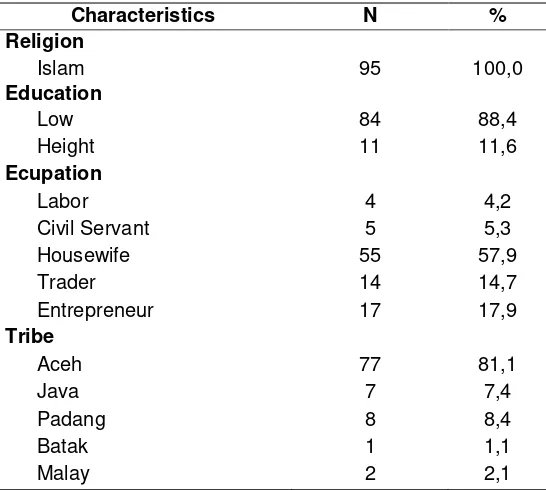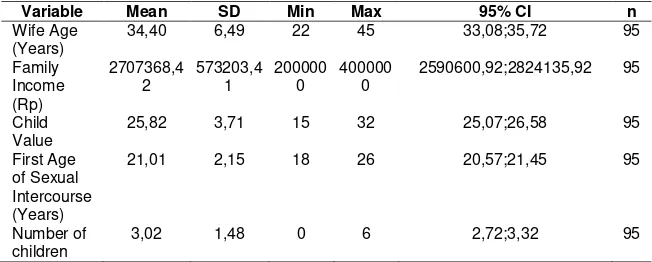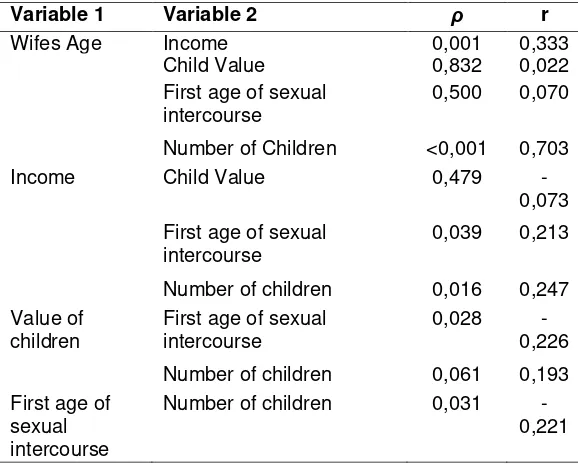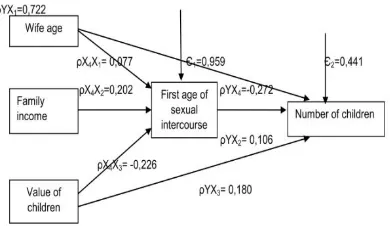46
Factors That Influence The Numbers of Children
in The Village Pusong Banda Sakti
Lhokseumawe City
Rika Mursyida1,a), Erna Mutiara2, Asfriyati3 1
STIKES Bumi Persada Lhokseumawe 2,3
Public Health Sciences USU-Medan
a)
ABSTRACT
The number of children means how many children owned by someone, usually in the form of the intended family size. Family size will be increased, along with the increase in the number of children because each family attempts to get the number of children by their own way. The objective of the research was to find out some factors influenced the number of children such as the factors of mother’s age, family income, and child value through the first age at exposure to sexual intercourse at Pusong Village, Banda Sakti Subdistrict, City of Lhokseumawe, in 2017. The research was observational with cross sectional design. The population was 246 wives of PUS (Fertile Age Couple) at Pusong Village, in January, 2017, and 95 of them were used as the samples, using simple random sampling technique. The data were analyzed by using path analysis. The result of the research showed that
simultaneously wife’s age, family income, child value, and the
first age at exposure to sexual intercourse influenced the number of children of 24.9%. Of the three independent variables, the variable of the first age at exposure to sexual intercourse influenced the number of children (ρ < 0.001) with the amount of influence was 24.9%, and the rest (75.1%) was influenced by other factors such as Family Planning,
education, and mother’s job. It is recommended that
community and religious leader at Pusong Village, as the
47 perception about the use of contraception device so that the community will believe that contraception device is halal (legitimate) and can be used by the wives of fertile age couple arranging their number of children.
Keywords: wife’s age, family income, child value, the first age at exposure to sexual intercourse, number of children
INTRODUCTION
The province of Nanggroe Aceh Darussalam, which is part of the country of Indonesia has a population of 4,597,308 people where the number of men is 2,300,442 people while women are 2,296,866 people there are 20.4% of them are children ie 938,300 people (Dinkes Aceh, 2017).
Based on the results of the 2012 Population Census enumeration, the number of residents of the temporary city of Lhokseumawe is 170,504 people, consisting of 84,893 men and 85,611 women. In the results of the 2010 Population Census it is apparent that the population of Lhokseumawe is still based in the Banda Sakti subdistrict of 42.92%, where in Pusong Village is part of this subdistrict which has 1175 families, with 347 children in 2010, 354 children in 2014 and 367 children in 2015 (Badan Pusat Statistik, BkkbN, Depkes RI, Macro International, 2015).
48 own wages to meet their needs so as not to burden the family. But there are also families who have children in the number of 2 people only, due to maternal health factors that are unable to continue the addition of the number of children due to sterilization.
The results of the initial survey conducted in the Village Pusong Banda Sakti Sub-District of Lhokseumawe City against 10 married mothers and have children, the number of children they have 2 - 7 children. When asked why they have many children because they have many children will have a lot of sustenance, children also become additional labor in meeting the needs of the family, with an average mother of basic education so it is difficult to receive information about family planning and consider that KB should not be in religion so that they tend to increase the number of children 2 to 3 more children because they believe children can find their own wages to meet their needs so as not to burden the family. But there are also families who have children in the number of 2 people only, due to maternal health factors that are unable to continue the addition of the number of children due to sterilization.
Family income in Pusong is low enough for basic needs but the number of children is not a problem for them as more and more children are sustaining the family economy. Whereas in 4 people (26.7 percent) of mothers aged over 35 years and having children> 2 said they would not limit the number of children it would only plan the distance of pregnancy, although the average child can only be schooled to finish elementary and junior high school due to the limitations economy which then follow the habits of the work of his father and mother as fishermen and fish dryers. Parents consider the needs of the child just the point while the affection, happiness, appreciation, recreation, not at all noticed.
49 financial burden of family, each child has his or her own sustenance, regardless of how many children they think the child is a sustenance to be grateful for and the understanding that every family should have a son as a lineage that continues the title of "Teungku, Sayed, Ampon" from the lineage of the old man - men. If a boy does not have a son then the offspring broke up and ended in a girl with a title cut "cut". This is a cultural belief that affects the number of children in a family.
Diana (2007) in Siregar (2011) says every family needs to measure the various factors that affect the number of children. From social aspect, health, finance to custom and culture. From a financial perspective, a family can measure the income capabilities comparable to the educational plan and the cost of fulfilling the needs and health of the child to be born. The planned child should have a quality of education and a guaranteed life. From the social side, the number of children can be adjusted to the social conditions of society, family, and various psychological factors. Starting from a personal desire, the ability to divide the time for children, until the carrying capacity of the environment is good for child growth.
Based on the results of research by Muchtar and Purnomo (2009), working women had slightly higher fertility than unemployed women (2.5 compared to 2.3 children), and the effect of significant fertility (ρ <0.05). When viewed by group of number of live birth children indicate that most women who work have children born alive 3 or more children, while women who do not work generally have not children and have between 1-2 children.
Furthermore, according to Muchtar and Purnomo (2009), the age of the first gathering is closely related to the fertility rate, since the age of the first gathering signifies the start of the female reproductive period. Therefore, the younger women begin to be sexually active, the longer the reproductive period, and ultimately the greater the likelihood of having many children. The first ages were grouped into,
≤15 years, 16-17 years, 18-19 years, 20-29 years, and 30+
50 Based on a description of the factors that affect the number of children above and the results of the preliminary survey that has been done, it is necessary to do research on what factors affect the number of children in the village of Pusong Kecamatan Banda Sakti Lhokseumawe Year 2017.
The purpose of this research is to know the factors that influence the number of children that is wife age, family income and the value of the child through the first age of sexual intercourse on the number of children in Pusong Village, Banda Sakti Sub-district, Lhokseumawe City 2017.
METHODS
The research type is observasional with cross sectional approach. Location of research in Pusong Village, Banda Sakti Sub-district, Lhokseumawe City. Population in this research is all wife of EFA who live in Pusong Village of Banda Sakti Sub-district of Lhokseumawe City in January 2016 as many as 246 people. The sample size is 95 people. The sampling is done by Simple Random Sampling, using a random C-Survey table to meet the desired sample size. The variables measured were wife's age, family income, children's value, age of first sexual intercourse and number of children. Data analysis used is Path Analysis (path analysis).
RESULTS AND DISCUSSION
51 Table 1. Distribution of Wife Elder Characteristics
Characteristics N %
Religion
Islam 95 100,0
Education
Low 84 88,4
Height 11 11,6
Ecupation
Labor 4 4,2
Civil Servant 5 5,3
Housewife 55 57,9
Trader 14 14,7
Entrepreneur 17 17,9
Tribe
Aceh 77 81,1
Java 7 7,4
Padang 8 8,4
Batak 1 1,1
Malay 2 2,1
Description of Wife Age, Family Income, Child Value, Age First Sexual Relationship and Number of Children
52 Table 2. Overview of Wife's Age, Family Income, Child Value, First Age Sexual Relationship, and Number of Children
Variable Mean SD Min Max 95% CI n
The result showed that wife age correlated with income (ρ = 0,001) and r = 0,333 mean wife age correlated weak (r <0,5), while number of child (ρ <0,001) and r = 0,703 mean wife age strongly correlated to number of children (r> 0.5).
53 Table 3. Relationship between Wife Age, Family Income, Child Value, First Age Sexual Relationship with Number of Children
Variable 1 Variable 2 ρ r
Wifes Age Income 0,001 0,333
Child Value 0,832 0,022
First age of sexual intercourse
0,500 0,070
Number of Children <0,001 0,703
Income Child Value 0,479
-0,073
First age of sexual intercourse
0,039 0,213
Number of children 0,016 0,247 Value of
children
First age of sexual intercourse
0,028
-0,226
Number of children 0,061 0,193 First age of
sexual intercourse
Number of children 0,031
-0,221
Model Estimation Parameters
54 Table 4. Direct Influence of Wife's Age, Family Income and Child Value to Number of Children
Variable B p R2
Wifes age 0,077 0,461
0,041
Family income 0,202 0,051
Value of Children -0,226 0,028
Based on Table 5 it was found that wife age (ρ <0.001) and age of first having sexual intercourse (ρ<0.001) had an indirect effect on the number of children. The overall effect on the number of children through the first age of sexual intercourse of 55.9%, while the remaining 44.1% influenced by other variables such as the use of contraceptives.
Table 5. Direct Influence of Wife's Age, Family Income and Values of Children on Number of Children through Age of First Sexual Relationships
Variable B p R2
Wife age 0,722 <0,001
0,559
Family income 0,106 0,314
Value of Children 0,180 0,084
First age of sexual intercourse -0,272 <0,001
Line Chart Influence of Wife Age, Family Income, Child Value, and First Age Sexual Relationship Against the Number of Children in Pusong Village, Banda Sakti Sub-district, Lhokseumawe City, 2017
55 family income of 20.2% and children's value of 22.6%, while 95.9% was influenced by other factors outside the model.
The number of children is 72,2% influenced by wife age, equal to 10.6% influenced by family income, children value equal to 18,0% and equal to 27,2% influenced by first age having sexual intercourse while 44,1% influenced by other factors outside the model.
Figure 1 Line Diagram Factors Affecting Number of Children in Pusong Village Banda Sakti Sub-District Lhokseumawe City.
Influence of Wife Age, Family Income and Values of Children Against Age First Sexual Relationship in Pusong Village, Banda Sakti Sub-district, Lhokseumawe City
Based on the results of regression analysis analysis that the age of wife and family income does not affect the first sexual intercourse, while the value of children affect the first sexual intercourse.
The magnitude of the simultaneous effect is 0.041 or 4.1% is the contribution of the wife age variable, family income, and the value of the child on the age of first sexual intercourse, while the rest 95.9% influenced by other factors outside the model.
56 matters of marriage. Because the first sexual intercourse is an activity of one partner, then they should also have a certain purpose. But because the first sexual intercourse consists of two individuals, then the possibility that their goals are not the same. When that happens, then the objective must be rounded so that there is a unity in the goal (Walgito, 2004).
The results showed that the mean age of first sexual intercourse of EFA wife in Pusong village of Banda Sakti subdistrict of Lhokseumawe City was 21 years old, this was influenced by Aceh culture which contained child value. From the results of the study found the cause of the number of women having the first sexual relationship at a fairly young age is because there is a growing cultural influence in the community that the daughter should be married in order not to become an old maid. If the daughter does not marry soon it will embarrass the family, regardless of age or marital status most parents accept the proposal because it assumes the future of the child will be better and the family is expected to reduce the burden of parents.
57 Age of first sexual intercourse is often found in poor areas or in rural areas. Economic limitations and low income causes parents rarely send their children to a higher level. Parents are trying to meet the needs of their families, so parents rarely encourage their children to go to school. Similarly, the fact that there is in society that the economic status of people is the reason most of the respondents cause the occurrence of marriage at a young age. The low income of the family so they can not send their children to school further. These conditions make the child feel the burden of parents and do not want to continue school so decided to get married early.
Influence of Wife's Age, Family Income, Values of Child and Age of First Sexual Relationship Against Number of Children in Pusong Village, Banda Sakti Sub-district, Lhokseumawe City
Based on the result of regression analysis that wife's age, children's value, and age of sexual intercourse influence to number of children, while income does not affect the number of children. Magnitude of simultaneous influence is 0,559 or 55,9% is contribution of wife age variable, family income, value of child and age of sexual intercourse to number of children in Pusong Village, while the rest 44,1% influenced by other factors outside model.
The age of the wife affects the number of children, the older the wife today, the more the number of children owned by these results indicates a positive relationship. This is also in line with Muchtar and Purnomo (2009), that in general the older the aged woman, the more number of children born. From the results of research Muchtar and Purnomo (2009) note that there is a relationship between the age of women with the birth rate showed a positive relationship, ie the older age the more births.
58 first sexual intercourse of the mother is caused by various possibilities such as increased levels of education, increased acceptance of information from various mass media, and efforts to improve job and career development. Thus, the higher the level of education, the easier it will be in receiving various information and knowledge relating to the number of children.
The value of the child will influence the decision of the parent to determine the desired number of children, the value of the child as requiring a son will make a person likely to have a son. the value of the child who declares that the child will be helpful in helping the parents work, can help the family finances and help care for his or her parents during illness will increase a person's tendency to have many children. There are three kinds of children's utility, namely: 1) as a consumer goods, for example as a source of entertainment, 2) as a means of production, the child is expected to perform a certain job that supplement the family income, 3) as a source of peace, good in the old days or vice versa. In developing countries children are regarded as investment goods or economic activity, that is, parents expect to receive economic benefits from children.
In rural areas children have a high value for the family. Children can give happiness to their parents and it will be a guarantee in the old age and can help the family economy, many people in the village in Indonesia who views that many children a lot of fortune. Families living in rural areas have many children on the grounds that children provide economic benefits and a sense of security for their families.
In stable marital status, the lower the age of the first sexual intercourse, the longer time spent in the process of reproduction. Therefore, people who have first sexual intercourse at a young age will be more childbearing. In times of climax, families with many children will consider the advantages and disadvantages of having children.
59 relationship between the first sexual intercourse with the number of children. The first marriage age can be an indicator of the start of a woman's chance to conceive and give birth. Women who had the first sexual intercourse of a young age had a longer timeframe to conceive and give birth than those who married older and had more children. The increase in the mean age of first sexual intercourse and the number of single women is closely related to the decline in fertility. Women who delayed having first sexual intercourse will have an average number of fewer children.
Most parents want children in moderation (3-5 children). This is in line with BkkbN stating that to lead a happy, prosperous and qualified family does not need to form large families with large numbers of children, if not able to meet family needs. Family needs are not just food needs, but there are other needs such as clothing, housing, education, health and future needs of children. The condition of the desired number of children changes now indicates that there is a shift in values adopted in the family pascasosialisasi KB. This fact also shows that families today, even in rural areas, respond to the weakness of their resources by limiting the number of children to fewer than the previous generation.
Limitations of Research
1. This research is an observational research with cross sectional approach where data retrieval is done only once simultaneously. Therefore this research does not intend to see the causal relationship between independent variables with dependent variable only gives information about the influence of independent variable to dependent variable through intervening variable / intermediary.
60 3. Samples in the path analysis of at least 100 respondents or at least 5 times the number of parameters to be estimated, even to produce a stable analysis requires a sample of more than 5000 respondents. Because the sample in this study 95 respondents or below of 100 respondents, the results of path analysis is less stable.
CONCLUSION
1. The influence of wife's age, family income and the value of the child on the first age of sexual intercourse of 10.4% and only 89.6% influenced by other factors such as education and wife's work.
2. The influence of wife's age, family income, children's value to the number of children through the first age of sexual intercourse of 59.3% and 40.7% influenced by other factors such as the use of contraceptives.
3. Age of wife has greater influence on the number of children through the first ages of sexual intercourse. If the older the wife age the more number of children born and vice versa. The first age of sexual intercourse at a young age has a long reproductive period, so the possibility of having many children.
SUGGESTION
1. To the community leaders and village religious leaders pusong lhokseumawe city as chairman of "tuha peut gampong" in order to straighten out negative understanding about the use of contraceptives so that people believe that halal contraceptives / can be used by wife of fertile couple to arrange the number of children. 2. For the Health Office of Lhokseumawe City, especially
61 possibility of children born will be minimized by usage contraception.
3. For wives of fertile-age couples to be more actively seeking information through print media, media information, electronic media about the benefits of the ideal number of children in the family, can also improve education or improve career at work so hopefully with high knowledge in making decisions has a small number of children to reach a small, healthy, happy and prosperous family.
REFERENCES
Badan Pusat Statistik (BPS), BKKBN, Depkes RI, Macro Internasional, 2015. Indonesia Demographic and Health Survey 2012, Calverton, Maryland, USA : BPS dan Macro Internasional.
Siregar, RY., 2011, Faktor yang Mendasari Penentuan Jarak Kehamilan Pada Pasangan Usia Subur (PUS) di RB.
Mahdarina, Padang Bulan.
http://repository.usu.ac.id/bitstream/123456789/23957/4/ Chapter%20II.pdf [diunduh pada tanggal 21 Februari 2014]
Dinkes Aceh, 2017, Profil Kesehatan Provinsi Aceh Tahun 2017, Banda Aceh
Dinkes Lhokseumawe, 2017, Profil Dinas Kesehatan Kota Lhokseumawe Tahun 2017, Lhokseumawe
Muchtar, R & Purnomo, E., 2009, Proximate Determinant Fertilitas di Indonesia, Puslitbang KB dan Kesehatan Reproduksi Badan Koordinasi Keluarga Berencana Nasional, Jakarta



